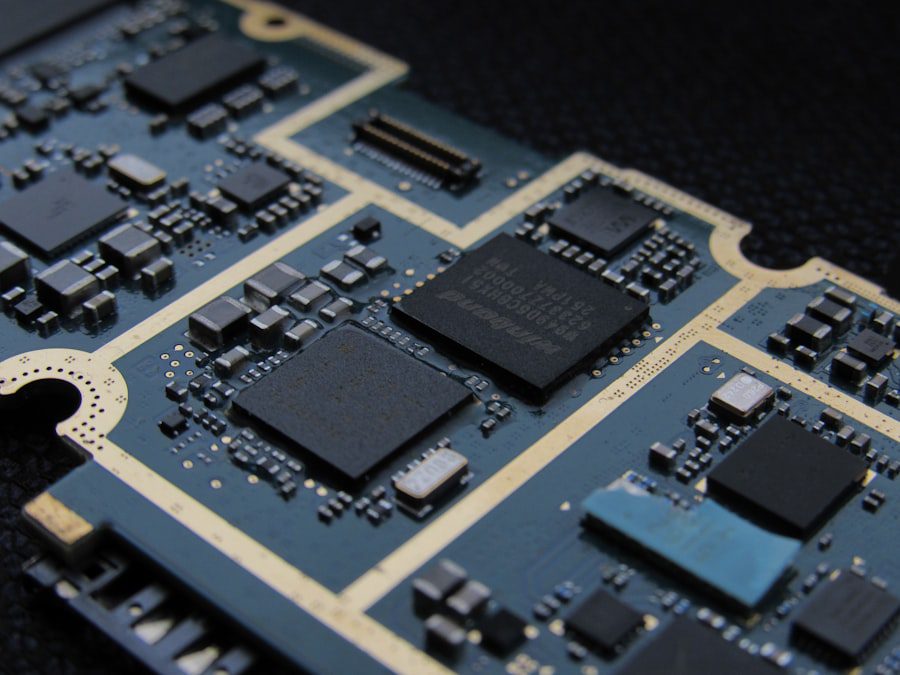The market for used CPU parts has gained significant traction in recent years, driven by a growing awareness of sustainability and cost-effectiveness among consumers. One of the primary benefits of purchasing used CPU components is the substantial cost savings they offer. New CPUs can be prohibitively expensive, especially high-performance models designed for gaming or intensive computational tasks.
By opting for used parts, consumers can access powerful processors at a fraction of the original price, allowing them to build or upgrade systems without breaking the bank. This financial advantage is particularly appealing to budget-conscious gamers, students, and small businesses looking to maximize their computing power without incurring excessive expenses. In addition to cost savings, buying used CPU parts contributes to environmental sustainability.
The electronics industry is notorious for its rapid obsolescence, leading to significant electronic waste. By choosing refurbished or second-hand components, consumers help reduce the demand for new manufacturing, which in turn lessens the environmental impact associated with resource extraction and production processes. Furthermore, many used CPU parts are still capable of delivering excellent performance, making them a viable option for those who prioritize both economic and ecological considerations.
This dual benefit of affordability and sustainability makes the used CPU market an attractive option for a wide range of users.
Key Takeaways
- Used CPU parts can offer significant cost savings compared to new parts, making them an attractive option for budget-conscious consumers.
- When purchasing used CPU parts, it’s important to consider factors such as the seller’s reputation, warranty options, and the condition of the parts.
- To ensure the quality of used CPU parts, buyers should thoroughly inspect the parts for any physical damage or signs of wear, and test them if possible before making a purchase.
- Proper installation and regular maintenance are crucial for maximizing the performance and lifespan of used CPU parts.
- Overclocking and other performance-boosting techniques can be effective for squeezing extra performance out of used CPU parts, but they should be approached with caution to avoid damaging the parts.
Factors to Consider When Purchasing Used CPU Parts
When venturing into the realm of used CPU parts, several critical factors must be taken into account to ensure a satisfactory purchase. First and foremost is the condition of the CPU itself. Buyers should inquire about the part’s history, including how it was used and whether it has undergone any repairs or modifications.
A well-maintained CPU that has been gently used in a non-demanding environment will likely perform better than one that has been subjected to heavy workloads or overclocking. Additionally, it is essential to check for any physical damage, such as bent pins or signs of overheating, which could indicate potential issues down the line. Another crucial factor is compatibility with existing hardware.
Before purchasing a used CPU, it is vital to verify that it is compatible with the motherboard and other components in the system. This includes checking socket types, chipset compatibility, and power requirements. Many CPUs have specific requirements that must be met for optimal performance, and failing to ensure compatibility can lead to wasted time and resources.
Furthermore, buyers should consider the potential for future upgrades; selecting a CPU that allows for expansion can extend the lifespan of a system and enhance its overall performance.
Tips for Ensuring the Quality of Used CPU Parts

To ensure that used CPU parts meet quality standards, buyers should adopt a systematic approach when evaluating potential purchases. One effective strategy is to purchase from reputable sellers or platforms that specialize in refurbished electronics. These vendors often provide warranties or guarantees on their products, offering buyers peace of mind regarding their investment.
Additionally, reading customer reviews and ratings can provide valuable insights into the seller’s reliability and the quality of their products. Another important tip is to conduct thorough research on the specific CPU model being considered. Understanding its specifications, performance benchmarks, and common issues can help buyers make informed decisions.
Websites dedicated to hardware reviews often provide detailed analyses of various CPUs, including their strengths and weaknesses. This knowledge can be instrumental in identifying potential red flags when evaluating used parts. Furthermore, if possible, buyers should request testing results or performance metrics from the seller to verify that the CPU functions as expected before finalizing the purchase.
Maximizing Performance Through Proper Installation and Maintenance
| Performance Metric | Measurement |
|---|---|
| Equipment Downtime | Hours per month |
| Energy Consumption | Kilowatt-hours (kWh) |
| Equipment Lifespan | Years |
| Maintenance Costs | Annual expenses |
Once a used CPU has been acquired, proper installation is crucial for maximizing its performance. This process begins with ensuring that all components are clean and free from dust or debris that could hinder functionality. Using thermal paste during installation is also essential; it facilitates efficient heat transfer between the CPU and cooler, preventing overheating and ensuring optimal performance.
Following manufacturer guidelines for installation can help avoid common pitfalls that may arise during this critical phase. Maintenance plays an equally important role in sustaining performance over time. Regularly monitoring temperatures and system performance can help identify potential issues before they escalate into significant problems.
Utilizing software tools to track CPU usage and temperature can provide insights into how well the system is performing under various loads. Additionally, keeping the system clean by removing dust from fans and heatsinks can prevent overheating and prolong the lifespan of the CPU. By adopting these practices, users can ensure that their used CPUs continue to deliver reliable performance for years to come.
Overclocking and Performance Boosting Techniques for Used CPU Parts
Overclocking presents an exciting opportunity for users looking to extract additional performance from their used CPU parts. This process involves running the CPU at higher speeds than its factory settings, which can lead to significant performance gains in demanding applications such as gaming or video editing. However, overclocking requires careful consideration of several factors, including cooling solutions and power supply capabilities.
Adequate cooling is essential to prevent overheating during overclocking; users may need to invest in aftermarket coolers or liquid cooling solutions to maintain safe operating temperatures. Before embarking on an overclocking journey, it is crucial to understand the specific capabilities and limitations of the chosen CPU model. Different CPUs have varying overclocking potential based on their architecture and manufacturing process.
Researching online forums and communities dedicated to overclocking can provide valuable insights into successful techniques and settings used by others with similar hardware configurations. Additionally, users should proceed cautiously by gradually increasing clock speeds while monitoring system stability through stress testing software. This methodical approach helps ensure that performance gains are achieved without compromising system integrity.
Compatibility and Upgradability Considerations for Used CPU Parts

Compatibility is a fundamental aspect when integrating used CPU parts into an existing system. Each CPU model is designed to work with specific motherboards based on socket type and chipset compatibility. For instance, an Intel Core i7 processor may not fit into a motherboard designed for AMD Ryzen CPUs due to differing socket designs.
Therefore, before purchasing a used CPU, it is imperative to verify that it aligns with the motherboard’s specifications. Additionally, checking for BIOS updates may be necessary to ensure that the motherboard can support newer CPU models. Upgradability is another critical consideration that can influence long-term satisfaction with a used CPU purchase.
Users should assess whether the chosen CPU allows for future upgrades without necessitating a complete system overhaul. For example, selecting a motherboard with support for multiple generations of CPUs can provide flexibility as technology evolves. This foresight enables users to enhance their systems incrementally rather than facing the daunting task of replacing entire setups when newer components become available.
Cost-Effective Strategies for Maximizing Performance with Used CPU Parts
Maximizing performance with used CPU parts involves strategic planning and resourcefulness. One effective strategy is to pair a used CPU with complementary components that enhance overall system performance without incurring excessive costs. For instance, investing in faster RAM or an SSD can significantly improve system responsiveness and reduce bottlenecks associated with slower storage solutions.
This approach allows users to create a balanced system where each component works harmoniously to deliver optimal performance. Another cost-effective strategy involves leveraging software optimizations to enhance performance further. Many operating systems offer built-in tools for managing system resources efficiently; utilizing these features can lead to noticeable improvements in responsiveness and speed.
Additionally, users can explore lightweight alternatives to resource-intensive applications that may strain older CPUs. By carefully selecting software that aligns with their hardware capabilities, users can maximize performance without requiring significant hardware investments.
Future Trends in the Used CPU Parts Market and Their Impact on Performance Maximization
The landscape of the used CPU parts market is continually evolving, influenced by technological advancements and shifting consumer preferences. One notable trend is the increasing availability of refurbished CPUs from manufacturers themselves, which often come with warranties and assurances of quality. This trend not only enhances consumer confidence but also encourages more users to consider purchasing used components as viable alternatives to new ones.
Moreover, as technology progresses, older CPUs are becoming more accessible at lower prices while still offering respectable performance levels for everyday tasks and gaming at lower settings. This democratization of technology allows a broader audience to engage with high-performance computing without incurring substantial costs. As more consumers embrace sustainability and cost-effectiveness in their purchasing decisions, the demand for used CPU parts is likely to grow, further shaping market dynamics.
In conclusion, understanding the benefits of used CPU parts involves recognizing their cost-effectiveness and environmental impact while considering factors such as compatibility and quality assurance during purchase decisions. By implementing proper installation techniques and maintenance practices, users can maximize performance while exploring overclocking options for additional gains. As trends in the market continue to evolve, consumers will find themselves increasingly empowered to make informed choices that enhance their computing experiences without compromising on quality or performance.
If you are interested in learning more about innovations in coal and briquette manufacturing, you should check out the article Clearing the Air: Clean Initiatives for Afghanistan. Lastly, if you are interested in ensuring quality briquette production and quality assurance, you should read the article Ensuring Quality Briquette Production and QA. These articles provide valuable insights into the industry and its advancements.
FAQs
What are used computer parts?
Used computer parts are components that have been previously owned and used in a computer system. These parts may include CPUs, motherboards, RAM, hard drives, and other hardware components.
Are used computer parts reliable?
The reliability of used computer parts can vary depending on factors such as the age of the component, how it was used, and its overall condition. It’s important to thoroughly inspect and test used parts before purchasing to ensure they are in good working order.
Where can I buy used computer parts?
Used computer parts can be purchased from various sources, including online marketplaces, computer hardware stores, and specialty retailers that specialize in refurbished or used components.
What are the benefits of buying used computer parts?
Buying used computer parts can be a cost-effective way to upgrade or repair a computer system. It can also be a more sustainable option by extending the lifespan of electronic components and reducing electronic waste.
What should I consider when buying used computer parts?
When buying used computer parts, it’s important to consider the condition of the component, its compatibility with your existing system, and the seller’s reputation. Additionally, be sure to inquire about any warranty or return policies for used parts.



